If you do
NOT see the Table of Contents frame to the left of this page, then
Click here to open 'USArmyGermany'
frameset |
Engineers in USFET & EUCOM 1940s
US Forces in the European Theater
Looking for more information from military/civilian
personnel assigned to or associated with the U.S. Army
in Germany from 1945 to 1989. If you have any
stories or thoughts on the subject, please contact me . .
|
|
|
|
|
| |
| The
1940s |
|
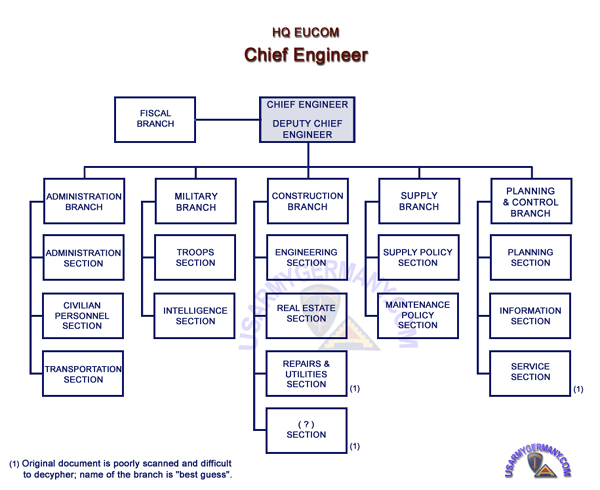
Chief Engineer (1), European Command, June 1948 |
| |
| (1) The Office of Chief Engineer was redesignated as the Engineer Division, European command on 8 April 1948; its divisions were renamed branches. |
|
| 1948 |
| (Source: Vol. IV, The Fourth Year of Occupation, OCCUPATION FORCES SERIES, Hq EUCOM, 1949) |
1. Trends During the Period (1 July 1948 - 31 Dec 1948)
Construction work continued on a large scale during the period but relatively few new projects were approved except those in support of Operation VITTLES (= Berlin Airlift). Attempts were made to reduce the amount of new construction in line with the EUCOM policy of reducing the demands of the occupation upon the German economy. An engineer conference to discuss the limitations imposed by the German budget for the 1949 fiscal year led to a curtailment of deutsche mark funds for engineer projects and a reduction in the number of German employees. During the period reorganization and consolidation at Hanau of the several engineer supply depots were completed and the surplus property was turned over to the Germans. Real estate holdings were further reduced. Checking of documents covering the sales of engineer surplus by Office of Foreign Liquidation Commissioner (OFLC) was completed. The closing out of damage and real estate accounts in France and Belgium progressed during the period but still involved considerable work before final settlements could be made.
2. Administration and Key Personnel
 a. Developments at Post and Command Level a. Developments at Post and Command Level
 The transfer of Kreis Weilheim from Garmisch to Munich Military Post on 13 August (1948) brought the EUCOM Engineer School under the jurisdiction of Munich Military Post. Regensburg Military Post was inactivated 1 November and responsibility for the area formerly serviced by that post was divided between Munich and Nürnberg Military Posts. At the same time a sub-post was set up at Grafenwohr to administer current construction in that area. Effective 1 July the various military posts became responsible for the establishment of field maintenance shops at each post. The Engineer Division assisted the posts in obtaining machine-shop equipment,
master mechanics, tools, and space allocations. A Maintenance Section was established in the Supply Branch, Engineer Division, to give technical assistance to engineer maintenance activities in the Command and to supervise the maintenance activities of units directly under the control of the Chief Engineer, EUCOM. Representatives of the Maintenance Section visited the various posts regularly. Studies were conducted during the latter part of the year to find ways to establish the repair and utilities functions of post engineers in the European Command so that they would operate in the same way as post engineers in the United States. The transfer of Kreis Weilheim from Garmisch to Munich Military Post on 13 August (1948) brought the EUCOM Engineer School under the jurisdiction of Munich Military Post. Regensburg Military Post was inactivated 1 November and responsibility for the area formerly serviced by that post was divided between Munich and Nürnberg Military Posts. At the same time a sub-post was set up at Grafenwohr to administer current construction in that area. Effective 1 July the various military posts became responsible for the establishment of field maintenance shops at each post. The Engineer Division assisted the posts in obtaining machine-shop equipment,
master mechanics, tools, and space allocations. A Maintenance Section was established in the Supply Branch, Engineer Division, to give technical assistance to engineer maintenance activities in the Command and to supervise the maintenance activities of units directly under the control of the Chief Engineer, EUCOM. Representatives of the Maintenance Section visited the various posts regularly. Studies were conducted during the latter part of the year to find ways to establish the repair and utilities functions of post engineers in the European Command so that they would operate in the same way as post engineers in the United States.
 b. Reorganization Within the Engineer Division b. Reorganization Within the Engineer Division
 Reorganization of the Engineer Division continued during the period under review. Authorized military strength was reduced from 24 officers and 34 enlisted men to 23 officers and 20 enlisted men on 1 October. At the same time the authorization for United States and Allied civilians was cut from 103 to 79. During the third quarter of 1948 a survey of civilian personnel in the Fiscal Branch was completed but no major changes were made. Civilian personnel positions in other branches were under survey at the end of the year. There were no changes in the authorization for German personnel in the Engineer Division but the total number of Germans in assigned units was reduced from 6,301 on 30 June to 3,487 on 31 December, or approximately 45 percent. During the third quarter the Construction Branch was redesignated the Operations Branch and the Engineering Section of the Operations Branch was changed to the Construction Section. Minor changes in designation were also made in the Administrative Branch. Organization of the Engineer Division as of 31 December is shown in Chart 1 (in lieu of the missing chart in the manuscript, the organization as of 30 June 1948 is offered above). The position of Comptroller was instituted on 15 September to perform the following functions: Reorganization of the Engineer Division continued during the period under review. Authorized military strength was reduced from 24 officers and 34 enlisted men to 23 officers and 20 enlisted men on 1 October. At the same time the authorization for United States and Allied civilians was cut from 103 to 79. During the third quarter of 1948 a survey of civilian personnel in the Fiscal Branch was completed but no major changes were made. Civilian personnel positions in other branches were under survey at the end of the year. There were no changes in the authorization for German personnel in the Engineer Division but the total number of Germans in assigned units was reduced from 6,301 on 30 June to 3,487 on 31 December, or approximately 45 percent. During the third quarter the Construction Branch was redesignated the Operations Branch and the Engineering Section of the Operations Branch was changed to the Construction Section. Minor changes in designation were also made in the Administrative Branch. Organization of the Engineer Division as of 31 December is shown in Chart 1 (in lieu of the missing chart in the manuscript, the organization as of 30 June 1948 is offered above). The position of Comptroller was instituted on 15 September to perform the following functions:
 (1) To advise the Chief Engineer, EUCOM, on development of engineer budget policies. This included a review of engineer personnel authorizations and quotas in order to determine adequate financial support for engineer operations. (1) To advise the Chief Engineer, EUCOM, on development of engineer budget policies. This included a review of engineer personnel authorizations and quotas in order to determine adequate financial support for engineer operations.
 (2) To act as personal representative of the Chief Engineer, EUCOM, at all budget hearings. (2) To act as personal representative of the Chief Engineer, EUCOM, at all budget hearings. |
| |
| Table 1 -- Total Actual Strength of Engineer Units, July - December 1948 |
| |
|
Month |
Officers |
|
Enlisted Men |
|
Civilians * |
|
|
| |
|
|
|
|
|
|
|
|
| |
Monthly Avg. |
611 |
|
6,596 |
|
75,891 |
|
|
| |
Jul |
639 |
|
7,189 |
|
59,461 |
|
|
| |
Aug |
625 |
|
6,569 |
|
69,219 |
|
|
| |
Sep |
607 |
|
6,337 |
|
82,454 |
|
|
| |
Oct |
601 |
|
6,521 |
|
87,683 |
|
|
| |
Nov |
601 |
|
6,282 |
|
78,319 |
|
|
| |
Dec |
595 |
|
6,676 |
|
77,778 |
|
|
| |
|
|
|
|
|
|
|
|
|
| * Includes US and Allied, direct-hire Germans, contract-hire Germans, and civilian labor service units |
| |
| Table 2 -- Average Strength of Engineer Units, 1 July - 31 December 1948 |
| |
|
Assigned Command |
Officers |
|
Enlisted Men |
|
Civilians * |
|
|
| |
|
|
|
|
|
|
|
|
| |
Engineer Division, EUCOM |
174 |
|
1,733 |
|
5,025 |
|
|
| |
Bremerhaven POE |
22 |
|
121 |
|
3,791 |
|
|
| |
US Air Forcres, Europe |
63 |
|
866 |
|
12,520 |
|
|
| |
US Forces in Austria |
54 |
|
584 |
|
1,267 |
|
|
| |
1st Infantry Division |
37 |
|
757 |
|
0 |
|
|
| |
US Constabulary |
51 |
|
1,022 |
|
0 |
|
|
| |
Berlin Military Post |
47 |
|
323 |
|
4,565 |
|
|
| |
Frankfurt Military Post |
32 |
|
283 |
|
9,367 |
|
|
| |
Heidelberg Military Post |
32 |
|
313 |
|
3,003 |
|
|
| |
Other Military Posts |
93 |
|
551 |
|
30,338 |
|
|
| |
|
|
|
|
|
|
|
|
|
| * Includes US and Allied, direct-hire Germans, contract-hire Germans, and civilian labor service units |
| |
| 3. (missing from copy of manuscript) |
| |
| Table 3 -- Number and Type of Engineer Units, 1 July 1948 - 1 January 1949 |
| |
|
|
1 JUL |
1 AUG |
1 SEP |
1 OCT |
1 NOV |
1 DEC |
1 JAN |
|
| |
Air Force Units |
|
|
|
|
|
|
|
|
| |
Aviation Battalion |
2 |
1 |
1 |
1 |
1 |
1 |
1 |
|
| |
Air Force Engineer Group |
0 |
1 |
1 |
1 |
1 |
1 |
1 |
|
| |
Aviation Group, Hq & Hq Sv Co |
1 |
0 |
0 |
0 |
0 |
0 |
0 |
|
| |
|
|
|
|
|
|
|
|
|
| |
Ground Force Units |
|
|
|
|
|
|
|
|
| |
Bridge Platoon |
0 |
0 |
0 |
0 |
0 |
0 |
1 (a) |
|
| |
Combat Battalion (divisional) |
1 |
1 |
2 (b) |
3 (b) |
3 (b) |
3 (b) |
3 (b) |
|
| |
Ponton Bridge Co, Rigid Boat |
0 |
0 |
1 (a) |
1 (a) |
1 (a) |
1 (a) |
1 (a) |
|
| |
|
|
|
|
|
|
|
|
|
| |
Service Units |
|
|
|
|
|
|
|
|
| |
Composite Service Group, Hq & Hq Det |
1 |
1 |
1 |
1 |
1 |
1 |
1 |
|
| |
Construction Battalion |
2 (b) |
2 (a) |
0 |
0 |
0 |
0 |
0 |
|
| |
Dump Truck Co (special) |
4 |
4 |
4 |
4 |
4 |
4 |
2 |
|
| |
Service Battalion, Hq &Hq Det |
3 |
3 |
3 |
3 |
3 |
3 |
3 |
|
| |
Service Battalion |
1 |
1 |
2 |
2 |
2 |
2 |
2 |
|
| |
Service Company Hqs |
3 |
3 |
3 |
3 |
3 |
3 |
3 |
|
| |
Supply & Maintenance Co |
1 |
1 |
1 |
1 |
1 |
1 |
1 |
|
| |
Supply & Maintenance Pltn |
2 |
2 |
2 |
0 |
0 |
0 |
0 |
|
| |
Utility Company |
6 |
6 |
6 |
6 |
6 |
6 |
6 |
|
| |
Service Company |
1 |
1 |
1 |
1 |
1 |
1 |
1 |
|
| |
|
|
|
|
|
|
|
|
|
| |
TD & A Units |
|
|
|
|
|
|
|
|
| |
Engineer Base Depot Group |
1 |
1 |
1 |
1 |
1 |
1 |
1 |
|
| |
Engineer Battalion, Hq & Hq Det |
1 |
1 |
1 |
1 |
1 |
1 |
1 |
|
| |
Engr Intelligence & Topo Co |
1 |
1 |
1 |
1 |
1 |
1 |
1 |
|
| |
Engineer School, Hq & Hq Det |
1 |
1 |
1 |
1 |
1 |
1 |
1 |
|
| |
|
|
|
|
|
|
|
|
|
| |
Labor Units |
|
|
|
|
|
|
|
|
| |
Labor Supervision Co Hqs |
16 |
17 |
17 |
17 |
16 |
15 |
15 |
|
| |
Labor Service Co (miscellaneous) |
17 |
19 |
19 |
19 |
17 |
16 |
16 |
|
| |
Labor Service Pltn |
0 |
0 |
0 |
1 |
2 |
2 |
2 |
|
| |
|
|
|
|
|
|
|
|
|
|
(a) Negro (African-American) personnel
(b) One Negro (African-American) battalion |
| |
| Table 4 -- Operational Assignment of Engineer Troop Units, 1 July - 31 December 1948 |
| |
| |
 1 JUL 48 1 JUL 48 |
|
 31 DEC 48 31 DEC 48 |
|
|
|
| |
7742 Engineer Base Depot Gp |
|
7742 Engr Base Depot Gp |
|
| |
7710 EUCOM Engineer School |
|
7710 EUCOM Engineer School |
|
| |
7714 Engineer Intelligence & Topographic Co |
|
7714 Engineer Intelligence & Topographic Co |
|
| |
555 Engineer Composite Service Group, HHD |
|
555 Engineer Composite Service Group, HHD |
|
| |
41 Engineer Dump Truck Co (special) |
|
-- |
|
| |
42 Engineer Dump Truck Co (special) |
|
42 Engineer Dump Truck Co (special) |
|
| |
43 Engineer Dump Truck Co (special) |
|
43 Engineer Dump Truck Co (special) |
|
| |
44 Engineer Dump Truck Co (special) |
|
-- |
|
| |
4 Engineer Supply & Maintenance Pltn |
|
-- |
|
| |
500 Engineer Supply & Maintenance Pltn |
|
-- |
|
| |
-- |
|
501 Engineer Utilities Company |
|
| |
502 Engineer Utilities Company |
|
502 Engineer Utilities Company |
|
|
| |
Bremerhaven Port of Embarkation |
|
|
| |
536 Engineer Service Bn |
|
536 Engineer Service Bn |
|
|
| |
|
| |
1 Engineer Combat Bn |
|
1 Engineer Combat Bn |
|
|
| |
|
| |
-- |
|
54 Engineer Combat Bn |
|
| |
547 Engineer Construction Bn (a) |
|
-- |
|
| |
-- |
|
547 Engineer Combat Bn (a) |
|
| |
555 Engineer Composite Service Group, HHD |
|
555 Engineer Composite Service Group, HHD |
|
| |
-- |
|
552 Engineer Ponton Bridge Co, Rigid Boat (a) |
|
| |
-- |
|
93 Engineer Bridge Pltn (a) |
|
|
| |
|
| |
7862 Engineer Battalion, Hq & Hq Det |
|
7862 Engineer Battalion, Hq & Hq Det |
|
| |
581 Engr Supply & Maintenance Co |
|
581 Engr Supply & Maintenance Co |
|
| |
579 Engineer Utilities Co |
|
579 Engineer Utilities Co |
|
|
| |
|
| |
501 Engineer Utilities Co |
|
501 Engineer Utilities Co |
|
|
| |
|
| |
252 Engineer Construction Bn |
|
-- |
|
| |
-- |
|
252 Engineer Service Bn |
|
|
| |
|
| |
831 Engineer Aviation Bn |
|
-- |
|
| |
862 Engineer Aviation Bn |
|
862 Engineer Aviation Bn |
|
| |
924 Engineer Aviation Gp, Hq & Hq Svc Co |
|
-- |
|
| |
-- |
|
7390 Air Force Engineer Group |
|
|
| |
|
| |
522 Engineer Service Bn, H/H Det |
|
522 Engineer Service Bn, H/H Det |
|
| |
523 Engineer Service Bn, H/H Det |
|
523 Engineer Service Bn, H/H Det |
|
| |
524 Engineer Service Bn, H/H Det |
|
524 Engineer Service Bn, H/H Det |
|
| |
586 Engineer Service Co Hqs |
|
586 Engineer Service Co Hqs |
|
| |
592 Engineer Service Co Hqs |
|
592 Engineer Service Co Hqs |
|
| |
640 Engineer Service Co Hqs |
|
640 Engineer Service Co Hqs |
|
| |
578 Engineer Utilities Co |
|
578 Engineer Utilities Co |
|
| |
582 Engineer Utilities Co |
|
582 Engineer Utilities Co |
|
| |
583 Engineer Utilities Co |
|
583 Engineer Utilities Co |
|
|
| |
4. Reorganization of Engineer Units
Monthly changes in number and type of Engineer units in the European Command from 1 July 1948 to 1 January 1949 are listed in Table 3. The considerable shifting, activation, inactivation, and redesignation of Engineer units, which took place during the period, was in line with changes in the areas of jurisdiction of military posts and the reorganization of the 1st Infantry Division, the U.S. Constabulary, and USAFE.
 a. Troop Units a. Troop Units
 An Engineer combat battalion, an Engineer ponton bridge company (rigid boat), and an Engineer bridge platoon were activated during the period to serve with the reorganized U.S. Constabulary. Two Engineer dump truck companies were transferred from Engineer Division, EUCOM, to military posts and finally inactivated at the end of the year. Two Engineer supply and maintenance platoons under the jurisdiction of the Engineer Division were also inactivated during the period. An Air Force Engineer group was activated, while an Aviation Engineer battalion and the headquarters and headquarters service company of an Aviation Engineer group were inactivated. In addition, two Engineer construction battalions were redesignated, one as an Engineer service battalion and one as an Engineer combat battalion. Operational assignments of Engineer troop units on 1 July 1948 and 31 December are given in Table 4. An Engineer combat battalion, an Engineer ponton bridge company (rigid boat), and an Engineer bridge platoon were activated during the period to serve with the reorganized U.S. Constabulary. Two Engineer dump truck companies were transferred from Engineer Division, EUCOM, to military posts and finally inactivated at the end of the year. Two Engineer supply and maintenance platoons under the jurisdiction of the Engineer Division were also inactivated during the period. An Air Force Engineer group was activated, while an Aviation Engineer battalion and the headquarters and headquarters service company of an Aviation Engineer group were inactivated. In addition, two Engineer construction battalions were redesignated, one as an Engineer service battalion and one as an Engineer combat battalion. Operational assignments of Engineer troop units on 1 July 1948 and 31 December are given in Table 4. |
| |
| Table 5 -- Operational Assignment of Engineer Labor Units, 1 July - 31 December 1948 |
| |
| |
 1 JUL 48 1 JUL 48 |
|
 31 DEC 48 31 DEC 48 |
|
|
|
| |
1076 Lab Supv Co Hq |
|
35 Lab Supv Co Hq |
|
| |
4041 Lab Svc Co (QM Labor) |
|
4041 Lab Svc Co (QM Labor) |
|
| |
1002 Lab Supv Co Hq |
|
-- |
|
| |
7132 Lab Svc Co (Const) |
|
-- |
|
| |
1046 Lab Supv Co Hq |
|
-- |
|
| |
8722 Lab Svc Co (Const) |
|
-- |
|
| |
1143 Lab Supv Co Hq |
|
43 Lab Supv Co Hq |
|
| |
6913 Lab Svc Co (Const) |
|
6913 Lab Svc Co (Const) |
|
| |
1963 Lab Supv Co Hq |
|
98 Lab Supv Co Hq |
|
| |
8361 Lab Svc Co (Const) |
|
8361 Lab Svc Co (Const) |
|
| |
-- |
|
8591 Lab Svc Pltn (Bridge Maint) |
|
|
| |
|
| |
8710 Lab Svc Co (Const) |
|
8710 Lab Svc Co (Const) |
|
|
| |
|
| |
-- |
|
8592 Lab Svc Pltn (Bridge Maint) |
|
|
| |
|
| |
1038 Lab Supv Co Hq |
|
23 Lab Supv Co Hq |
|
| |
8895 Lab Svc Co (Const) |
|
8895 Lab Svc Co (Const) |
|
| |
1049 Lab Supv Co Hq |
|
27 Lab Supv Co Hq |
|
| |
8252 Lab Svc Co (Const) |
|
8252 Lab Svc Co (Const) |
|
| |
1584 Lab Supv Co Hq |
|
67 Lab Supv Co Hq |
|
| |
8145 Lab Svc Co (Const) |
|
8145 Lab Svc Co (Const) |
|
| |
1953 Lab Supv Co Hq |
|
-- |
|
| |
8707 Lab Svc Co (Maint) |
|
-- |
|
|
| |
|
| |
1029 Lab Supv Co Hq |
|
-- |
|
| |
8717 Lab Svc Co (Const) |
|
-- |
|
| |
1139 Lab Supv Co Hq |
|
84 Lab Supv Co Hq |
|
| |
8184 Lab Svc Co (Const) |
|
8184 Lab Svc Co (Const) |
|
| |
1217 Lab Supv Co Hq |
|
52 Lab Supv Co Hq |
|
| |
8745 Lab Svc Co (Const) |
|
8745 Lab Svc Co (Const) |
|
| |
1875 Lab Supv Co Hq |
|
-- |
|
| |
8121 Lab Svc Co (Depot) |
|
-- |
|
| |
1918 Lab Supv Co Hq |
|
41 Lab Supv Co Hq |
|
| |
8716 Lab Svc Co (Const) |
|
8716 Lab Svc Co (Const) |
|
|
| |
|
| |
-- |
|
11 Lab Supv Co Hq |
|
| |
-- |
|
7132 Lab Svc Co (Const) |
|
| |
-- |
|
20 Lab Supv Co Hq |
|
| |
-- |
|
8717 Lab Svc Co (Const) |
|
| |
-- |
|
25 Lab Supv Co Hq |
|
| |
-- |
|
8722 Lab Svc Co (Const) |
|
| |
-- |
|
77 Lab Supv Co Hq |
|
| |
-- |
|
8610 Lab Svc Co (Const) |
|
| |
-- |
|
517 Lab Supv Co Hq |
|
| |
-- |
|
8850 Lab Svc Co (Const) |
|
|
| |
|
| |
1891 Lab Supv Co Hq |
|
-- |
|
| |
8610 Lab Svc Co (Const) |
|
-- |
|
|
| |
| |
|
| |
1071 Lab Supv Co Hq |
|
33 Lab Supv Co Hq |
|
| |
8724 Lab Svc Co (Const) |
|
8724 Lab Svc Co (Const) |
|
|
| |
 b. Labor Units b. Labor Units
 All labor supervision company headquarters were redesignated in August. Two labor service platoons for bridge maintenance were activated during the period. Two labor service companies (one depot and one maintenance) were inactivated along with their labor supervision company headquarters. One service company (construction) and a headquarters company for it were activated. Units were transferred to Wetzlar Military Post from the Engineer Division, and then to Nürnberg Military Post. Others were transferred from Regensburg and USAFE to Nürnberg during the period. Operational assignments of Engineer labor units at the beginning and end of the period are given in Table 5. All labor supervision company headquarters were redesignated in August. Two labor service platoons for bridge maintenance were activated during the period. Two labor service companies (one depot and one maintenance) were inactivated along with their labor supervision company headquarters. One service company (construction) and a headquarters company for it were activated. Units were transferred to Wetzlar Military Post from the Engineer Division, and then to Nürnberg Military Post. Others were transferred from Regensburg and USAFE to Nürnberg during the period. Operational assignments of Engineer labor units at the beginning and end of the period are given in Table 5.
5. Manning and Map Reproduction
Engineer activities with regard to mapping and map reproduction during the period consisted of map reproduction by the 7714th Intelligence and Topographical Company at the Frankfurt Base Plant and a mobile section (while a new base plant was being completed at Schwetzingen), photomapping, map storage and issue, a control recovery program with regard to mapping the U.S. Zone, and various intelligence missions,
 a. Base Plants a. Base Plants
 By the end of 1948 the Schwetzingen Base Plant was ready to begin reproducing maps and other impressions. Skilled German employees had been hired. Major construction work had been completed, and most of the machinery was ready for final testing prior to placing the plant in full operation. Pending the development of the Schwetzingen Base Plant to full operating capacity, map reproduction activities continued at the Frankfurt Base Plant. During the last quarter of 1948, a total of 3,148,700 map impressions and 307,350 miscellaneous impressions were made by the Frankfurt plant. By the end of 1948 the Schwetzingen Base Plant was ready to begin reproducing maps and other impressions. Skilled German employees had been hired. Major construction work had been completed, and most of the machinery was ready for final testing prior to placing the plant in full operation. Pending the development of the Schwetzingen Base Plant to full operating capacity, map reproduction activities continued at the Frankfurt Base Plant. During the last quarter of 1948, a total of 3,148,700 map impressions and 307,350 miscellaneous impressions were made by the Frankfurt plant.
 b. Mobile Section b. Mobile Section
 The mobile platoon of the reproduction section continued the printing of maps and miscellaneous items. During the period under review, the platoon printed 2,992,175 impressions, including 2,602,300 mans. To meet the deadline for mapsheets of the 4414-series, urgently needed for EUCOM winter maneuvers, a temporary two-shift system of operations was set up by the section in December. The platoon also trained personnel and supervised the setting up of equipment in the new base plant. The mobile platoon of the reproduction section continued the printing of maps and miscellaneous items. During the period under review, the platoon printed 2,992,175 impressions, including 2,602,300 mans. To meet the deadline for mapsheets of the 4414-series, urgently needed for EUCOM winter maneuvers, a temporary two-shift system of operations was set up by the section in December. The platoon also trained personnel and supervised the setting up of equipment in the new base plant.
 c. Minor Intelligence Projects c. Minor Intelligence Projects
 The number of minor intelligence projects increased steadily. Projects were considered minor until a higher agency indicated interest or a higher relative value was indicated by field survey. Several trips were made during the period to evaluate material. On these field trips an effort was also made to clarify Engineer intelligence-collecting policies and to gain additional sources of information. The number of minor intelligence projects increased steadily. Projects were considered minor until a higher agency indicated interest or a higher relative value was indicated by field survey. Several trips were made during the period to evaluate material. On these field trips an effort was also made to clarify Engineer intelligence-collecting policies and to gain additional sources of information.
 d. Other Activities of the 7714th Engineer Intelligence and Topographic Company d. Other Activities of the 7714th Engineer Intelligence and Topographic Company
 Early in the period a large number of aerial photographs were segregated, indexed, and shipped to the Air Force by the Photomapping Section. Until December, when replacements brought the Photomapping Section to full strength, the work of editing, correcting, computing, and drawing grids for mapsheets in the 4414-series was considerably retarded by a shortage of trained personnel. The program of reboxing, segregating, inventorying, and warehousing maps at the Map Depot Section was completed during the period except for the 4414-series. Boxes for this series were not received in sufficient quantities from the Hanau Engineer Depot to complete the program. The Survey Section continued to supervise the German Land Survey Office at Bamberg, which computed adjustments for certain European triangulation nets. In the Control Recovery Program in the U.S. Zone, all field and office work in Hesse had been completed by the end of the year, field work in Württemberg-Baden had been completed along with about 70 percent of the office work, and vertical control in Bavaria had been completed along with 90 percent of the office work. In December the Survey Section was field-checking recovery cards and maps. It was estimated that this project would be completed in August 1949. Projects of the Intelligence Section during the second half of 1948 included classifying strategically roads and bridges in the Grafenwohr area, making vicinity maps of the crossing site at Frankenthal Autobahn Bridge, analyzing and processing GROUNDHOG material, completing the Rhine bridge and ferry report, completing the Mainz River Report, and compiling topographic data. Early in the period a large number of aerial photographs were segregated, indexed, and shipped to the Air Force by the Photomapping Section. Until December, when replacements brought the Photomapping Section to full strength, the work of editing, correcting, computing, and drawing grids for mapsheets in the 4414-series was considerably retarded by a shortage of trained personnel. The program of reboxing, segregating, inventorying, and warehousing maps at the Map Depot Section was completed during the period except for the 4414-series. Boxes for this series were not received in sufficient quantities from the Hanau Engineer Depot to complete the program. The Survey Section continued to supervise the German Land Survey Office at Bamberg, which computed adjustments for certain European triangulation nets. In the Control Recovery Program in the U.S. Zone, all field and office work in Hesse had been completed by the end of the year, field work in Württemberg-Baden had been completed along with about 70 percent of the office work, and vertical control in Bavaria had been completed along with 90 percent of the office work. In December the Survey Section was field-checking recovery cards and maps. It was estimated that this project would be completed in August 1949. Projects of the Intelligence Section during the second half of 1948 included classifying strategically roads and bridges in the Grafenwohr area, making vicinity maps of the crossing site at Frankenthal Autobahn Bridge, analyzing and processing GROUNDHOG material, completing the Rhine bridge and ferry report, completing the Mainz River Report, and compiling topographic data.
6. Reorganization of Supply Administration and Planning
 a. Administration a. Administration
 The program of consolidating Engineer depots was completed during the period. Excess Engineer supplies at three sub-depots (Mannheim, Fürth, and Gelnhausen) were turned over to the Germans and the installations were released from the control of the Chief Engineer, EUCOM. Mannheim Engineer Sub-Depot released 7,082 long tons of supplies to the Germans; Fürth, 7,665 long tons; and Gelnhausen, 20,792 long tons. Agencies receiving real estate released by these sub-depots were Heidelberg, Nürnberg, and Frankfurt Military Posts respectively. Hanau Engineer Base Depot became the central engineer agency for the European Command. Operational supply levels for the depot were based upon logistical forecasts prepared by EUCOM Headquarters and detailed construction requirement reports submitted by major commands 150 days before contemplated use. Engineer supply requirements based on these two factors were consolidated by line item, reviewed, compared with previous issues, and revised to meet budget limitations. Items procurable from the German economy were grouped into commodity classifications and submitted to the Bipartite Control Office for approval of procurement by the depot. Class IV items not procurable in Germany were purchased elsewhere in Europe as appropriated dollar funds were made available. Such purchases were negligible during the third quarter and amounted to $482,738.63 in the fourth quarter of 1948. Class II items not procurable in Germany were requisitioned from the United States in accordance with Department of the Army directives and authorizations. The program of consolidating Engineer depots was completed during the period. Excess Engineer supplies at three sub-depots (Mannheim, Fürth, and Gelnhausen) were turned over to the Germans and the installations were released from the control of the Chief Engineer, EUCOM. Mannheim Engineer Sub-Depot released 7,082 long tons of supplies to the Germans; Fürth, 7,665 long tons; and Gelnhausen, 20,792 long tons. Agencies receiving real estate released by these sub-depots were Heidelberg, Nürnberg, and Frankfurt Military Posts respectively. Hanau Engineer Base Depot became the central engineer agency for the European Command. Operational supply levels for the depot were based upon logistical forecasts prepared by EUCOM Headquarters and detailed construction requirement reports submitted by major commands 150 days before contemplated use. Engineer supply requirements based on these two factors were consolidated by line item, reviewed, compared with previous issues, and revised to meet budget limitations. Items procurable from the German economy were grouped into commodity classifications and submitted to the Bipartite Control Office for approval of procurement by the depot. Class IV items not procurable in Germany were purchased elsewhere in Europe as appropriated dollar funds were made available. Such purchases were negligible during the third quarter and amounted to $482,738.63 in the fourth quarter of 1948. Class II items not procurable in Germany were requisitioned from the United States in accordance with Department of the Army directives and authorizations.
 b. Planning b. Planning
 Because of major changes in logistical planning during the last quarter of 1948, basic assumptions previously used in determining engineer supply missions were dropped. New assumptions, based on a continued heavy construction load, an increase in the population supported, a long-term occupation program, and the end of surplus disposal activities, required extensive changes in supply procedures. All of these changes were not firm by the end of the year. Because of major changes in logistical planning during the last quarter of 1948, basic assumptions previously used in determining engineer supply missions were dropped. New assumptions, based on a continued heavy construction load, an increase in the population supported, a long-term occupation program, and the end of surplus disposal activities, required extensive changes in supply procedures. All of these changes were not firm by the end of the year.
7. Procurement in Germany
Procurement in Germany during the second half of 1948 consisted of headquarters procurement and field procurement.
 a. Headquarters Procurement a. Headquarters Procurement
 Headquarters procurement consisted of long-term wholesale purchasing to meet quarterly Engineer supply requirements. During the period 1 July - 30 September it amounted to 6,033,620 DM, of which 6,001,280 DM was for materials and 32,340 DM was for services. Operational responsibility for such procurement belonged to the Commanding Officer, Hanau Engineer Base Depot, By the end of 1948 there were four Engineer procurement teams and two sub-teams under the administration of the Commanding Officer, Hanau Engineer Base Depot: Headquarters procurement consisted of long-term wholesale purchasing to meet quarterly Engineer supply requirements. During the period 1 July - 30 September it amounted to 6,033,620 DM, of which 6,001,280 DM was for materials and 32,340 DM was for services. Operational responsibility for such procurement belonged to the Commanding Officer, Hanau Engineer Base Depot, By the end of 1948 there were four Engineer procurement teams and two sub-teams under the administration of the Commanding Officer, Hanau Engineer Base Depot:
 (1) The Wiesbaden Engineer Procurement Team was responsible for procurement in Greater Hesse. Typical items purchased included lumber, cement, electrical equipment, chemicals, paint, bricks, boilers and heating equipment, carbon tetrachloride, and refrigerating gases. (1) The Wiesbaden Engineer Procurement Team was responsible for procurement in Greater Hesse. Typical items purchased included lumber, cement, electrical equipment, chemicals, paint, bricks, boilers and heating equipment, carbon tetrachloride, and refrigerating gases.
 (2) The Munich Engineer Procurement Team, employing a sub-team at Nürnberg, was responsible for procurement in Bavaria. Typical supplies purchased were lumber, cement, industrial gases, paint, glue, hardware, composition board, incandescent lamps, clay products, and glass. (2) The Munich Engineer Procurement Team, employing a sub-team at Nürnberg, was responsible for procurement in Bavaria. Typical supplies purchased were lumber, cement, industrial gases, paint, glue, hardware, composition board, incandescent lamps, clay products, and glass.
(page missing - remainder of Section 7, first part of Section 8)
 a. Solid Fuel Storage and Reconsignment Points a. Solid Fuel Storage and Reconsignment Points
 During the period there were two solid fuel storage and reconsignment points under the Commanding Officer, Hanau Engineer Base Depot: (1) the Rheinau Engineer Solid Fuels Point, located at Mannheim-Rheinau in Heidelberg Military Post; which received and consigned coal fuels to the various military posts and air installations. This installation had under contract approximately 2,109,000-square feet of open storage space and 60,000 square feet of closed storage apace; and (2) the Kassel Coal Point, located at Kassel in Wetzlar Military Post, which reconsigned loaded rail cars entering the U.S. Zone from the Ruhr. This installation had no storage facilities. The cars were reconsigned to points in the U.S. Zone without unloading. During the period there were two solid fuel storage and reconsignment points under the Commanding Officer, Hanau Engineer Base Depot: (1) the Rheinau Engineer Solid Fuels Point, located at Mannheim-Rheinau in Heidelberg Military Post; which received and consigned coal fuels to the various military posts and air installations. This installation had under contract approximately 2,109,000-square feet of open storage space and 60,000 square feet of closed storage apace; and (2) the Kassel Coal Point, located at Kassel in Wetzlar Military Post, which reconsigned loaded rail cars entering the U.S. Zone from the Ruhr. This installation had no storage facilities. The cars were reconsigned to points in the U.S. Zone without unloading.
 b. Procurement of Solid Fuels b. Procurement of Solid Fuels
 Solid fuels for United States occupation requirements were procured through the Joint US - UK Coal Authority, Bipartite Control Office. Major commands received coal to meet the requirements of the population supported and facilities occupied. Stocks at EUCOM storage and reconsignment points on 31 December 1948 equaled 18.3 days' supply and other local military stocks equaled 40.4 days' supply at January consumption rates. Solid fuels procured in the fourth quarter of 1948 cost 13,600,000 DM. Solid fuels for United States occupation requirements were procured through the Joint US - UK Coal Authority, Bipartite Control Office. Major commands received coal to meet the requirements of the population supported and facilities occupied. Stocks at EUCOM storage and reconsignment points on 31 December 1948 equaled 18.3 days' supply and other local military stocks equaled 40.4 days' supply at January consumption rates. Solid fuels procured in the fourth quarter of 1948 cost 13,600,000 DM.
9. Rebuild Plants
The number of German firms assisting in the repair of unserviceable equipment was reduced from eleven to four during the second half of 1948. The following rebuild shops were under the jurisdiction of the Commanding Officer, Hanau Engineer Base Depot, at the end of the period:
 (1) Uhingen Rebuild Shop, located at the German Daimler-Benz factory, Uhingen, in Stuttgart Military Post, which rebuilt truck-mounted and crawler-mounted cranes. This installation had 56,000 square feet of shop space and 24,000 square feet of parking storage space; (1) Uhingen Rebuild Shop, located at the German Daimler-Benz factory, Uhingen, in Stuttgart Military Post, which rebuilt truck-mounted and crawler-mounted cranes. This installation had 56,000 square feet of shop space and 24,000 square feet of parking storage space;
 (2) Fulda Rebuild Shop, located at the German Karl Schmidt factory, Fulda, in Wetzlar Military Post, which rebuilt all types and sizes of Engineer generators. It had 49,390 square feet of shop space and 58,780 square feet of parking storage space; (2) Fulda Rebuild Shop, located at the German Karl Schmidt factory, Fulda, in Wetzlar Military Post, which rebuilt all types and sizes of Engineer generators. It had 49,390 square feet of shop space and 58,780 square feet of parking storage space;
 (3) Nürnberg Rebuild Shop, located at the M.A.N. Diesel factory, Nürnberg, which rebuilt all types of Engineer tractors. It had 33,000 square feet of shop space and 147,000 square feet of storage space; and (3) Nürnberg Rebuild Shop, located at the M.A.N. Diesel factory, Nürnberg, which rebuilt all types of Engineer tractors. It had 33,000 square feet of shop space and 147,000 square feet of storage space; and
 (4) Backnang Rebuild Shop, located at the German Kraeble Brothers factory, Backnang, in Stuttgart Military Post, which rebuilt all types of Engineer graders, rollers, and air compressors. It had 4,460 square feet of shop space and 17,740 square feet of parking storage space. (4) Backnang Rebuild Shop, located at the German Kraeble Brothers factory, Backnang, in Stuttgart Military Post, which rebuilt all types of Engineer graders, rollers, and air compressors. It had 4,460 square feet of shop space and 17,740 square feet of parking storage space.
(List of the seven other rebuild shops)
10. Other Supply Operations
 a. Supply Support to 1st Infantry Division and U.S. Constabulary a. Supply Support to 1st Infantry Division and U.S. Constabulary
 Reorganization of the 1st Infantry Division and the U.S. Constabulary required reequipping units in accordance with new Tables of Organization and Equipment. Equipment not immediately available was requisitioned from the United States. Reorganization of the 1st Infantry Division and the U.S. Constabulary required reequipping units in accordance with new Tables of Organization and Equipment. Equipment not immediately available was requisitioned from the United States.
(page missing - remainder of Section 10, first part of Section 11)
man hours per month over the average for the period April through June. Almost 70 percent of the total, approximately 10,600,000 man hours per month, continued to be spent in maintenance and housekeeping activities, in spite of the fact that a large amount of work, such as the repainting of buildings, was reclassified as construction instead of maintenance. Construction work continued on a relatively large scale during the period although attempts were made to reduce the amount of new construction in line with the EUCOM policy of reducing as much as possible the burden of the occupation on the German economy. Factors affecting the number of man hours spent on construction during the period were favorable weather for completing previously approved outdoor work and special requirements for support of Operation VITTLES. Overhead and miscellaneous activities required approximately 2,350,000 man hours per month, slightly less than during previous quarters. A breakdown of the number of man hours spent on the various types of Engineer operations is shown in Table 6. A breakdown of the same totals by major commands is given in Table 7. |
| |
| Table 6 -- Engineer Operations by Type of Project (man hours), 21 June - 20 December 1948 |
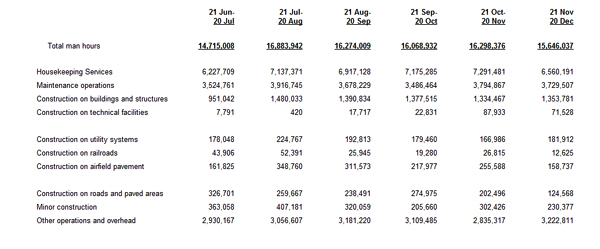
Click on table for larger image |
| |
| Table 7 -- Engineer Operations by Commands (man hours), 21 June - 20 December 1948 |
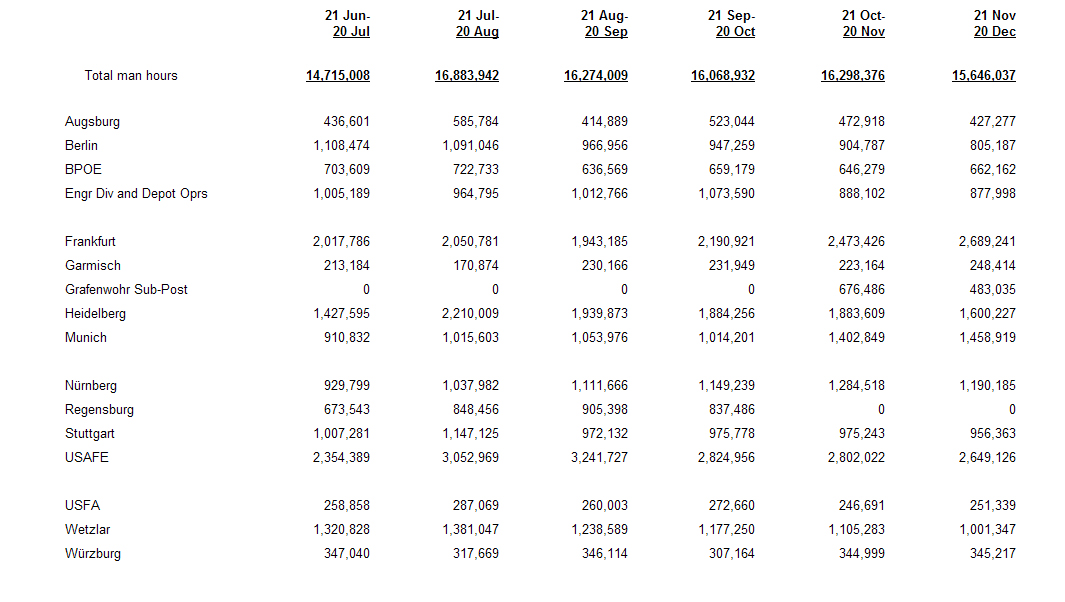
Click on table for larger image |
| |
12. Construction Proiects
During the calendar year 1948, 20,476,377 man hours were expended on major Engineer construction projects and 3,338,035 were spent on minor projects of less than 5,000 man hours each. The total number of man hours expended, 23,814,412, was approximately 75 percent of the 31,901,140 man hours approved during 1948 or officially carried over from the 1947 calendar year. A breakdown showing the man hours of work completed, approved, and carried over from 1947, by major projects, is given in Table 8. It was estimated on 31 December 1948 that major and minor construction to support the European Command during the German fiscal year (1 April 1948 - 31 March 1949) would require 28,100,000 man hours, of which 67 percent or 18,640,000 men hours had been completed by the end of the third quarter. |
| |
| Table 8 -- Construction Projects (man hours), 1948 Calendar Year |
|
|
Carry-over
from 47 cal-
endar year |
|
Total
approved
31 Dec 48
|
|
Total
completed
20 Dec 48 |
|
|
| |
|
|
|
|
|
|
|
|
| |
Grand total |
5,528,800 |
|
31,901,140 |
|
23,814,412 |
|
|
| |
Total minor construction (less than 5,000 man hours) |
-- |
|
3,500,000 |
|
3,338,035 |
|
|
| |
Total approved major construction |
5,528,800 |
|
28,401,140 |
|
20,476,377 |
|
|
| |
|
|
|
|
|
|
|
|
|
| Approved major construction |
| |
Giessen Quartermaster Depot |
1,000,000 |
|
1,799,699 |
|
1,853,696 |
|
|
| |
Hanau Engineer Depot |
415,000 |
|
836,332 |
|
822,547 |
|
|
| |
Griesheim Ordnance Depot |
300,000 |
|
445,090 |
|
384,111 |
|
|
| |
Mannheim Ordnance Depot |
78,300 |
|
257,150 |
|
223,570 |
|
|
| |
Ordnance Rebuild Plants |
408,800 |
|
960,890 |
|
743,089 |
|
|
| |
|
|
|
|
|
|
|
|
| |
Kitzingen Training Center |
125,000 |
|
187,060 |
|
192,240 |
|
|
| |
Grafenwoehr Training Center (incl. Vilseck) |
1,600 |
|
2,807,900 |
|
1,347,192 |
|
|
| |
Rhein-Main Air Base (incl. Operation VITTLES) |
1,708,900 |
|
4,503,913 |
|
3,016,880 |
|
|
| |
|
|
|
|
|
|
|
|
| |
Tegel Air Base |
-- |
|
383,200 |
|
122,984 |
|
|
| |
Tempelhof Air Base |
-- |
|
907,880 |
|
294,795 |
|
|
| |
Fürstenfeldbruck Air Base |
101,700 |
|
696,060 |
|
338,585 |
|
|
| |
Erding Air Depot |
12,200 |
|
722,647 |
|
373,160 |
|
|
| |
Wiesbaden Air Base (incl. Operation VITTLES) |
233,400 |
|
2,347,479 |
|
1,308,799 |
|
|
| |
|
|
|
|
|
|
|
|
| |
Kaufbeuren Air Base |
-- |
|
240,640 |
|
107,873 |
|
|
| |
Oberpfaffenhofen Air Depot |
-- |
|
76,020 |
|
48,285 |
|
|
| |
Neubiberg Air Base |
-- |
|
492,083 |
|
416,980 |
|
|
| |
Projects incident to EUCOM move to Heidelberg |
-- |
|
2,043,589 |
|
1,324,597 |
|
|
| |
|
|
|
|
|
|
|
|
| |
Nürnberg dependent housing |
-- |
|
218,500 |
|
125,606 |
|
|
| |
Radio Station and Information Center, Berlin |
-- |
|
243,655 |
|
223,555 |
|
|
| |
Radio Station and Information Center, Nürnberg |
-- |
|
116,500 |
|
20,299 |
|
|
| |
|
|
|
|
|
|
|
|
| |
Bremen Enclave (misc. construction & rehabilitation) |
-- |
|
78,800 |
|
28,771 |
|
|
| |
Münster Ammunition Depot |
7,200 |
|
198,252 |
|
182,574 |
|
|
| |
Hanau Kasernes: Argonne, Pioneer, Wolfgang, Kastel |
208,000 |
|
808,420 |
|
561,698 |
|
|
| |
|
|
|
|
|
|
|
|
| |
Munich Quartermaster Depot |
48,000 |
|
188,960 |
|
108,102 |
|
|
| |
Darmstadt Quartermaster Depot |
32,000 |
|
56,790 |
|
40,341 |
|
|
| |
Hanau Signal Depot |
5,200 |
|
135,500 |
|
58,906 |
|
|
| |
Schwabisch Hall Kaserne (rehabilitation) |
55,000 |
|
176,510 |
|
103,081 |
|
|
| |
|
|
|
|
|
|
|
|
| |
Kasernes: Nürnberg Fürth (rehabilitation ) |
-- |
|
254,000 |
|
254,492 |
|
|
| |
Sonthofen Construction School |
38,000 |
|
122,400 |
|
69,214 |
|
|
| |
Herzo Base (misc. construction) |
7,800 |
|
70,470 |
|
16,242 |
|
|
| |
|
|
|
|
|
|
|
|
| |
Landsberg Air Ammunition Depot |
-- |
|
64,150 |
|
57,800 |
|
|
| |
Misc. smaller projects |
742,700 |
|
5,960,601 |
|
5,706,313 |
|
|
|
| |
| Note: Approved carry-over from the 1947 calendar year (Column I) is included in the running total approved during the 1948 calendar year (Column II) |
| |
|
13. Operation VITTLES
The Engineer Division was responsible for construction and maintenance of airfields, runways, ramps, buildings, and hardstands needed to support Operation VITTLES. Early in the period under review, large quantities of Engineer equipment required for construction of new airstrips in Berlin were collected at Hanau Engineer Base Depot. Over one hundred pieces of equipment, including tractors, graders, rollers, scrapers, asphalt distributors, generators, and crushing and screening plants, were dismantled at Hanau, shipped by air to Berlin, and reassembled. This operation often required cutting the frames of some of the larger pieces of equipment and rewelding them in Berlin. By the end of the year, runway construction at Tempelhof Airfield in Berlin was 99 percent complete and that at Tegel Airfield was 97 percent complete. By the end of the year, a total of 2,608,620 man hours of work had been approved for VITTLES projects, of which almost half was for runways, taxiways, and aprons. As airfield construction neared completion, attention was directed more and more toward improving accommodations for VITTLES personnel. To provide adequate accommodations in Berlin and Frankfurt, new barracks were constructed, existing buildings were rehabilitated, and messes, clubs, and other recreation centers were brought to higher standards. |
| |
| Table 9 -- Survey of Enemy War Installations, 25 December 1948 |
|
Type of installation |
Number
located |
|
Number
destroyed |
|
In use |
|
| |
|
|
|
|
|
|
|
| |
Minefields and other explosive obstructions |
94.3 sq km |
|
94.3 sq km |
|
0 |
|
| |
Nonexplosive obstacles and field obstacles on main Allied lines of communication and across German defensive systems |
11.74 km |
|
11.74 km |
|
0 |
|
| |
Fundamental defensive construction on main routes |
1,304 |
|
1,304 |
|
0 |
|
| |
Pens for submarines, E-boats, R-boats |
1 |
|
1 |
|
0 |
|
| |
Permanent fortified land constructions |
1,968 |
|
1, 913 |
|
55 |
|
| |
All other types of permanent obstacles not shown in item 2 |
61.4 km |
|
61.4 km |
|
0 |
|
| |
Special weapons, installations, V-weapons |
22 |
|
22 |
|
0 |
|
| |
Permanent fortified coastal defense construction |
24 |
|
24 |
|
0 |
|
| |
Fighter control and radar installations |
24 |
|
24 |
|
0 |
|
| |
Base and operation airfields (surplus to Allied requirements) |
142 |
|
142 |
|
0 |
|
| |
Antiaircraft installations |
571 |
|
571 |
|
0 |
|
| |
Underground facilities, depots, workshops |
201 |
|
174 |
|
27 |
|
| |
Military and public air raid shelters |
5,570 |
|
4,297 |
|
1,273 |
|
| |
Underground communications cables (surplus to authorized Allied and German civil requirements) |
3 |
|
3 |
|
0 |
|
| |
Overhead lines of communication (surplus to Allied and German civil requirements) |
18 |
|
18 |
|
0 |
|
| |
Fixed radio stations (surplus to Allied and German civil requirements) |
22 |
|
22 |
|
0 |
|
| |
Underground and surface centers of communication and relay stations (surplus to Allied and German civil requirements) |
23 |
|
23 |
|
0 |
|
| |
Military scientific research centers, also testing grounds |
47 |
|
46 |
|
1 |
|
| |
Ranges (surplus to Allied requirements) |
136 |
|
136 |
|
0 |
|
| |
Depots of war materials (surplus to Allied requirements) |
135 |
|
135 |
|
0 |
|
| |
Major strategic bulk POL storage installations (surplus to Allied requirements) |
6 (a) |
|
5 (b) |
|
1 (c) |
|
| |
Camps and barracks installations |
4,080 |
|
72 |
|
4,008 |
|
| |
Barrack-installations and camps (kasernes) |
72 |
|
1 (d) |
|
68 |
|
| |
Emergency war housing (military) |
81 |
|
4 |
|
77 |
|
| |
Hospitals |
147 |
|
1 |
|
146 |
|
| |
Headquarters and administrative installations |
96 |
|
3 (e) |
|
89 |
|
| |
Convalescent and recreation centers |
39 |
|
2 |
|
37 |
|
| |
Schools (military) |
18 |
|
1 |
|
17 |
|
| |
Naval Depots |
3 |
|
0 |
|
3 |
|
| |
Ground Force Depots |
266 |
|
1 |
|
259 (f) |
|
| |
Air Force Depots |
8 |
|
0 |
|
8 |
|
| |
Ground Force Arsenals |
45 |
|
1 |
|
44 |
|
| |
Naval Arsenals |
1 |
|
0 |
|
1 |
|
|
| |
(a) 920,440 cubic meters
(b) 820,440 cubic meters
(c) 100,000 cubic meters
(d) 3 salvaged
(e) 4 salvaged
(f) 6 others left intact
|
| |
14. Destruction of Enemy War Installations
The resurveying of German war installations continued during the second half of 1948. Due to the critical shortage of civilian and troop housing and of storage facilities, current directives required specific approval by the Engineer Division for the destruction of any existing enemy war installations. No barrack-type installations had been destroyed in the U.S. Zone since the German surrender. Records and reports of the demolition program were checked against the field situation to determine whether installations retained were being used for approved purposes and whether the required changes had been made to remove the possibility of their use for war purposes. The status of enemy war installations as of 25 December is shown in Table 9.
15. Real Estate
 a. Reduction of Holdings a. Reduction of Holdings
 During the second half of 1948, military posts continued the program of reducing real estate costs. In spite of a slight increase in facilities under requisition during the third quarter, monthly rentals declined steadily. Real estate holdings for 30 June, 30 September, and 31 December, were as follows: During the second half of 1948, military posts continued the program of reducing real estate costs. In spite of a slight increase in facilities under requisition during the third quarter, monthly rentals declined steadily. Real estate holdings for 30 June, 30 September, and 31 December, were as follows: |
|
|
30 Jun |
|
30 Sep |
|
31 Dec |
|
|
| |
|
|
|
|
|
|
|
|
| |
Facilities under requisition |
19,129 |
|
19,240 |
|
19,074 |
|
|
| |
Facilities under confiscation |
1,153 |
|
1,093 |
|
1,074 |
|
|
| |
Monthly rentals (deutsche marks) |
8,305,181 |
|
7,749,824 |
|
7,307,983 |
|
|
| |
|
|
|
|
|
|
|
|
|
 b. Outstanding Accounts b. Outstanding Accounts
 In July 1948 damage charges for French properties released between 1 April 1947 and 31 March 1948 were forwarded to American (Graves) Registration Command (AGRC) by French authorities. These damage bills were paid by AGRC during the fourth quarter of 1948. Payment was from civil, not Engineer Service, funds. All necessary screening and checking of surplus property documents covering sales of items by the Office of the Foreign Liquidation Commissioner was completed during the period. An evaluation of bridges and bridging transferred to the Belgian Government was completed. Real estate claims of the Belgian Government totaling $415,484 were paid during the fourth quarter. Negotiations toward a blanket settlement of all charges and the execution of a quit-claim for the period 1 July 1946 - 31 March 1947 were progressing. The Belgian Government was expected to present a final figure before 1 February 1949. In July 1948 damage charges for French properties released between 1 April 1947 and 31 March 1948 were forwarded to American (Graves) Registration Command (AGRC) by French authorities. These damage bills were paid by AGRC during the fourth quarter of 1948. Payment was from civil, not Engineer Service, funds. All necessary screening and checking of surplus property documents covering sales of items by the Office of the Foreign Liquidation Commissioner was completed during the period. An evaluation of bridges and bridging transferred to the Belgian Government was completed. Real estate claims of the Belgian Government totaling $415,484 were paid during the fourth quarter. Negotiations toward a blanket settlement of all charges and the execution of a quit-claim for the period 1 July 1946 - 31 March 1947 were progressing. The Belgian Government was expected to present a final figure before 1 February 1949.
 c. I.G. Farben Properties c. I.G. Farben Properties
 With the establishment of the I.G. Farben Commission as a receiver for the I.G. Farben Industries, measures were taken by Engineer Division during the third quarter to secure payment for I.G. Farben properties held by the United States Forces since 19 July 1945. About 90 percent of these facilities were located in Frankfurt Military Post. Payments amounted to 1,655,000 DM for FY 1946, 3,450,000 DM for FY 1947, and 2,435,000 DM for FY 1948. With the establishment of the I.G. Farben Commission as a receiver for the I.G. Farben Industries, measures were taken by Engineer Division during the third quarter to secure payment for I.G. Farben properties held by the United States Forces since 19 July 1945. About 90 percent of these facilities were located in Frankfurt Military Post. Payments amounted to 1,655,000 DM for FY 1946, 3,450,000 DM for FY 1947, and 2,435,000 DM for FY 1948.
16. Intelligence
 a. War Projects a. War Projects
 Army funds made available during the fourth quarter permitted resumption of intelligence activities which had been curtailed during the third quarter of 1948. During the period under review, seven major intelligence projects were initiated and eleven were completed. This reduced the number of active projects from thirty-one on 30 June to twenty-seven on 31 December. Army funds made available during the fourth quarter permitted resumption of intelligence activities which had been curtailed during the third quarter of 1948. During the period under review, seven major intelligence projects were initiated and eleven were completed. This reduced the number of active projects from thirty-one on 30 June to twenty-seven on 31 December.
 b. Other Activities b. Other Activities
 The workload performance in putting documents through the standard checking procedures and in
operating a technical library and reproduction service is indicated in the following figures: The workload performance in putting documents through the standard checking procedures and in
operating a technical library and reproduction service is indicated in the following figures:
|
|
|
Third Quarter |
|
Fourth Quarter |
|
|
|
|
| |
Processing documents |
|
|
|
|
|
|
|
| |
Documents received |
529 |
|
775 |
|
|
|
|
| |
Documents transmitted |
1,700 |
|
1,103 |
|
|
|
|
| |
|
|
|
|
|
|
|
|
| |
Technical library |
|
|
|
|
|
|
|
| |
Documents received & catalogued |
809 |
|
1,978 |
|
|
|
|
| |
Requests for information |
1,050 |
|
1,050 |
|
|
|
|
| |
Documents on loan |
575 |
|
650 |
|
|
|
|
| |
Maps issued |
-- |
|
5,786 |
|
|
|
|
| |
|
|
|
|
|
|
|
|
| |
Reproduction service |
|
|
|
|
|
|
|
| |
Job orders |
168 |
|
228 |
|
|
|
|
| |
Photostats (positives) |
8,814 |
|
5,108 |
|
|
|
|
| |
Photostats (negatives) |
2,862 |
|
1,166 |
|
|
|
|
| |
Blue and White and Ozalids |
6,705 |
|
3,455 |
|
|
|
|
| |
|
|
|
|
|
|
|
|
|
17. Training
 a. EUCOM Engineer School a. EUCOM Engineer School
 The EUCOM Engineer School was responsible for the greater part of the technical training of Engineer troops during the second half of 1948. A total of 695 military and 516 German students were graduated during the period under review. A breakdown of the courses offered and the number of students graduated is shown in Table 10. Training at the school was not limited to Engineer troops; a large percentage of the students represented other branches of service of the Army and the Air forces. The EUCOM Engineer School was responsible for the greater part of the technical training of Engineer troops during the second half of 1948. A total of 695 military and 516 German students were graduated during the period under review. A breakdown of the courses offered and the number of students graduated is shown in Table 10. Training at the school was not limited to Engineer troops; a large percentage of the students represented other branches of service of the Army and the Air forces. |
| |
| Table 10 -- Engineer School Graduates |
| |
|
|
JUL |
AUG |
SEP |
OCT |
NOV |
DEC |
Total |
|
| |
Course |
|
|
|
|
|
|
|
|
| |
 Total military personnel Total military personnel |
87 |
120 |
118 |
145 |
87 |
138 |
695 |
|
| |
|
|
|
|
|
|
|
|
|
| |
Demolition |
0 |
52 |
18 |
20 |
16 |
23 |
129 |
|
| |
Draftsman |
0 |
0 |
0 |
8 |
0 |
14 |
22 |
|
| |
Electrician |
13 |
0 |
13 |
9 |
0 |
8 |
43 |
|
| |
Engineer Supply technician |
13 |
11 |
11 |
10 |
12 |
12 |
69 |
|
| |
Firefighter |
9 |
0 |
11 |
6 |
0 |
9 |
35 |
|
| |
|
|
|
|
|
|
|
|
|
| |
Fire pump maintenance |
0 |
10 |
7 |
0 |
0 |
0 |
17 |
|
| |
Machinist |
2 |
1 |
1 |
4 |
6 |
1 |
15 |
|
| |
Mechanic, construction equipment |
13 |
0 |
9 |
0 |
8 |
0 |
30 |
|
| |
Mechanic, Diesel |
11 |
0 |
0 |
0 |
9 |
0 |
20 |
|
| |
Mechanic, refrigeration |
0 |
9 |
0 |
7 |
0 |
6 |
22 |
|
| |
|
|
|
|
|
|
|
|
|
| |
Mines and booby traps |
0 |
37 |
0 |
0 |
14 |
0 |
51 |
|
| |
Operator, air compressor |
0 |
0 |
0 |
9 |
4 |
0 |
13 |
|
| |
Operator, crane and shovel |
11 |
0 |
13 |
16 |
0 |
16 |
56 |
|
| |
Operator, dozer |
15 |
0 |
10 |
13 |
0 |
16 |
54 |
|
| |
Operator, road grader |
0 |
0 |
10 |
9 |
0 |
8 |
27 |
|
| |
|
|
|
|
|
|
|
|
|
| |
Real estate |
0 |
0 |
0 |
0 |
18 |
0 |
18 |
|
| |
Safety procedure |
0 |
0 |
0 |
8 |
0 |
0 |
8 |
|
| |
Utility repairman |
0 |
0 |
15 |
14 |
0 |
13 |
42 |
|
| |
Welder |
0 |
0 |
0 |
12 |
0 |
12 |
24 |
|
| |
|
|
|
|
|
|
|
|
|
| |
 Total German personnel Total German personnel |
107 |
14 |
107 |
126 |
71 |
91 |
516 |
|
| |
|
|
|
|
|
|
|
|
|
| |
Clerk, stock record |
17 |
14 |
0 |
14 |
16 |
0 |
61 |
|
| |
Depot packing and crating |
0 |
0 |
0 |
11 |
0 |
0 |
11 |
|
| |
Firefighter |
44 |
0 |
54 |
45 |
0 |
40 |
183 |
|
| |
|
|
|
|
|
|
|
|
|
| |
Fire pump maintenance |
0 |
0 |
0 |
21 |
24 |
9 |
54 |
|
| |
Household packing and crating |
0 |
0 |
12 |
0 |
0 |
7 |
19 |
|
| |
Mechanic, construction equipment |
11 |
0 |
0 |
12 |
0 |
0 |
23 |
|
| |
Mechanic, ignition and carburetion |
7 |
0 |
9 |
0 |
15 |
0 |
31 |
|
| |
|
|
|
|
|
|
|
|
|
| |
Mechanic, refrigeration |
0 |
0 |
13 |
0 |
12 |
0 |
25 |
|
| |
Operator, crane |
14 |
0 |
14 |
0 |
4 |
11 |
43 |
|
| |
Warehouseman |
14 |
0 |
5 |
16 |
0 |
12 |
47 |
|
| |
Welder |
0 |
0 |
0 |
7 |
0 |
12 |
19 |
|
| |
|
|
|
|
|
|
|
|
|
|
| |
 b. Secondary Training Missions b. Secondary Training Missions
 All Engineer units with secondary training missions were tested during the third quarter. Units which failed were retested. The training of units assigned secondary training missions was considered excellent during the fourth quarter. All such units were given final tests and were considered proficient in their assigned missions. Training was cut to two hours per month for all personnel who passed. Those not tested and newly assigned continued to train two hours per week. All Engineer units with secondary training missions were tested during the third quarter. Units which failed were retested. The training of units assigned secondary training missions was considered excellent during the fourth quarter. All such units were given final tests and were considered proficient in their assigned missions. Training was cut to two hours per month for all personnel who passed. Those not tested and newly assigned continued to train two hours per week.
18. Repairs and Utilities
 a. Preventive Maintenance a. Preventive Maintenance
 A preventive maintenance program was inaugurated during the final quarter of 1948. The program was instituted to conserve manpower, improve health and morale, reduce repairs and utilities' costs, and increase the useful life of buildings and other real property by correcting minor errors before they became serious. A preventive maintenance program was inaugurated during the final quarter of 1948. The program was instituted to conserve manpower, improve health and morale, reduce repairs and utilities' costs, and increase the useful life of buildings and other real property by correcting minor errors before they became serious.
 b. Other Repairs and Utilities Activities b. Other Repairs and Utilities Activities
 Studies were conducted to determine whether the repairs and utilities functions of post engineers in the European Command might be established on the same level as those of post engineers in the United States. In the third quarter, surveys of requirements for winterizing ordnance and heavy-equipment-maintenance shops and Operation VITTLES facilities were conducted. All EUCOM cold storage plants were surveyed to insure that they were in optimum working condition. Major packing and crating problems were solved and emphasis was placed on the proper marking and securing of containers. Wood and wood-products conservation was stressed during the third quarter and the use of surplus quartermaster cases for packing and crating was studied. Studies were conducted to determine whether the repairs and utilities functions of post engineers in the European Command might be established on the same level as those of post engineers in the United States. In the third quarter, surveys of requirements for winterizing ordnance and heavy-equipment-maintenance shops and Operation VITTLES facilities were conducted. All EUCOM cold storage plants were surveyed to insure that they were in optimum working condition. Major packing and crating problems were solved and emphasis was placed on the proper marking and securing of containers. Wood and wood-products conservation was stressed during the third quarter and the use of surplus quartermaster cases for packing and crating was studied.
 c. Water Supply c. Water Supply
 The water supply system serving Grafenwohr Training Area was surveyed during the third quarter to insure adequate and hygienic water. Since many water supply systems in use by U.S. Forces had never been officially approved by the Chief Surgeon, in spite of chlorination and other minimum precautions, a comprehensive survey was undertaken during the period to bring all systems up to standard. This survey was completed during the fourth quarter. Surveys were also made to insure that necessary standby equipment was issued to all posts where needed. Additional chlorination equipment was procured from several German manufacturers to provide stocks for current requirements. The water supply system serving Grafenwohr Training Area was surveyed during the third quarter to insure adequate and hygienic water. Since many water supply systems in use by U.S. Forces had never been officially approved by the Chief Surgeon, in spite of chlorination and other minimum precautions, a comprehensive survey was undertaken during the period to bring all systems up to standard. This survey was completed during the fourth quarter. Surveys were also made to insure that necessary standby equipment was issued to all posts where needed. Additional chlorination equipment was procured from several German manufacturers to provide stocks for current requirements.
 d. Electric Power and Light d. Electric Power and Light
 A fluorescent lighting system, designed by the Engineer Division, was installed at EUCOM Headquarters. This system was expected to result in a saving of approximately 30 percent in electric power and at the same time to increase the standard of illumination. Similar systems were planned for other installations. A fluorescent lighting system, designed by the Engineer Division, was installed at EUCOM Headquarters. This system was expected to result in a saving of approximately 30 percent in electric power and at the same time to increase the standard of illumination. Similar systems were planned for other installations.
 e. Fire Prevention Week e. Fire Prevention Week
 In connection with Fire Prevention Week (3 - 9 October 1948), the Planning and Control Branch, Engineer Division, in cooperation with other EUCOM Divisions, prepared and distributed posters and a proclamation signed by General Clay. Fire Prevention Week, which featured newspaper publicity, radio announcements, fire drills, and parades throughout the Command, served to emphasize both to occupation personnel and to the German population the importance of fire prevention. Preliminary plans were made for a Fire Prevention Week in 1949. In connection with Fire Prevention Week (3 - 9 October 1948), the Planning and Control Branch, Engineer Division, in cooperation with other EUCOM Divisions, prepared and distributed posters and a proclamation signed by General Clay. Fire Prevention Week, which featured newspaper publicity, radio announcements, fire drills, and parades throughout the Command, served to emphasize both to occupation personnel and to the German population the importance of fire prevention. Preliminary plans were made for a Fire Prevention Week in 1949.
 f. Fire Regulations f. Fire Regulations
 In October 1948, a revised EUCOM circular on fire regulations was published to provide a working guide for the fire service. A monthly fire-run report, listing all fire runs and losses at military posts, was initiated during the last quarter. In October 1948, a revised EUCOM circular on fire regulations was published to provide a working guide for the fire service. A monthly fire-run report, listing all fire runs and losses at military posts, was initiated during the last quarter.
19. Engineer Fiscal Matters
 a. Curtailed 1949 German Budget a. Curtailed 1949 German Budget
 Several conferences to discuss means of alleviating difficulties imposed on the Engineer mission in the European Command by the stringent German budget for the 1949 fiscal year were held from 8 - 19 September in the office of the Deputy Budget and Fiscal Director. The conferences, called by the Chief Engineer, were attended by representatives of all post commanders, post engineers, and post fiscal officers. The conferences produced an immediate adjustment of funds by projects, a curtailment of less urgent Engineer activities, and a reduction in the number of German personnel employed by the Engineers. The needs of the posts amounted to 32,000,000 DM more than had been allocated. The Engineer Division, however, absorbed the entire amount by releasing approximately 15,000,000 DM held in reserve and drastically reducing the headquarters procurement program. It was anticipated that approximately 5,000,000 DM would be recouped for headquarters procurement from monthly rentals paid in dollars and subsequently converted into deutsche marks. By the end of the year, however, refunds reported by finance officers totaled only 1,342,686 DM. Several conferences to discuss means of alleviating difficulties imposed on the Engineer mission in the European Command by the stringent German budget for the 1949 fiscal year were held from 8 - 19 September in the office of the Deputy Budget and Fiscal Director. The conferences, called by the Chief Engineer, were attended by representatives of all post commanders, post engineers, and post fiscal officers. The conferences produced an immediate adjustment of funds by projects, a curtailment of less urgent Engineer activities, and a reduction in the number of German personnel employed by the Engineers. The needs of the posts amounted to 32,000,000 DM more than had been allocated. The Engineer Division, however, absorbed the entire amount by releasing approximately 15,000,000 DM held in reserve and drastically reducing the headquarters procurement program. It was anticipated that approximately 5,000,000 DM would be recouped for headquarters procurement from monthly rentals paid in dollars and subsequently converted into deutsche marks. By the end of the year, however, refunds reported by finance officers totaled only 1,342,686 DM.
 b. The 1950 German Budget b. The 1950 German Budget
 The German budget (Fiscal Year 1950) for the Engineer Division was submitted to the Deputy Director, Budget and Fiscal Division, in December 1948. Under this budget, the Quartermaster Division would budget and fund mess personnel previously included in the Engineer budget. Similarly, billeting personnel were to be budgeted and funded under the Army Finance System. The German budget (Fiscal Year 1950) for the Engineer Division was submitted to the Deputy Director, Budget and Fiscal Division, in December 1948. Under this budget, the Quartermaster Division would budget and fund mess personnel previously included in the Engineer budget. Similarly, billeting personnel were to be budgeted and funded under the Army Finance System.
 c. Appropriated Funds c. Appropriated Funds
 Invoices and receiving reports obtained for all open-market purchases and contract accounts covering appropriated-fund procurement in Allied and neutral countries were audited, vouchered, and submitted to appropriate accounting and disbursing officers for payment. No backlog existed on 31 December 1948. Invoices and receiving reports obtained for all open-market purchases and contract accounts covering appropriated-fund procurement in Allied and neutral countries were audited, vouchered, and submitted to appropriate accounting and disbursing officers for payment. No backlog existed on 31 December 1948.
|
|
ADDITIONAL INFORMATION
I. Other German Firms Repairing (Engineer) Equipment (from Vol IV, 4th Quarter, THIRD YEAR - April - June 1948)
List does not include the three (Uhingen, Backnang, and Fulda Rebuild shops) already mentioned in Section 9 - Rebuild Plants
 (1) FMA Pokorny, located in Frankfurt (Frankfurt Military Post) rebuilt air compressors; (1) FMA Pokorny, located in Frankfurt (Frankfurt Military Post) rebuilt air compressors;
 (2) Beihnoren Electrical Shop, located in Hanau (Frankfurt Military Post) rebuilt electric motors; (2) Beihnoren Electrical Shop, located in Hanau (Frankfurt Military Post) rebuilt electric motors;
 (3) Sabel & Scheurer, located in Oberursel (Frankfurt Military Post) manufactured flat motor bearings; (3) Sabel & Scheurer, located in Oberursel (Frankfurt Military Post) manufactured flat motor bearings;
 (4) Vulcan Diesel Plant, located in Bremen (BPOE) repaired tractors in the Bremen and Berlin Areas; (4) Vulcan Diesel Plant, located in Bremen (BPOE) repaired tractors in the Bremen and Berlin Areas;
 (5) Karl Wolfe, located in Göppingen (Stuttgart Military Post) rebuilt starters, fuel pumps, generators, carburetors, magnetos and Diesel fuel injector pumps; (5) Karl Wolfe, located in Göppingen (Stuttgart Military Post) rebuilt starters, fuel pumps, generators, carburetors, magnetos and Diesel fuel injector pumps;
 (6) Daimler-Benz, located in Stuttgart (Stuttgart Military Post) was responsible for spart parts supply; (6) Daimler-Benz, located in Stuttgart (Stuttgart Military Post) was responsible for spart parts supply;
 (7) Alfred Teves, located in Frankfurt (Frankfurt Military Post) was responsible for piston ring supply; (7) Alfred Teves, located in Frankfurt (Frankfurt Military Post) was responsible for piston ring supply;
 (8) Fritz Leitz Machine Works, located in Oberkochen (Stuttgart Military Post) rebuilt general items. (8) Fritz Leitz Machine Works, located in Oberkochen (Stuttgart Military Post) rebuilt general items. |
| |
| II. Engineer Supply and Maintenance Installations (from Vol IV, 4th Quarter, THIRD YEAR - April - June 1948) |
| |
Installations |
|
Type of Operation |
|
Assignment |
| |
Hanau Engineer Base Depot |
|
Base Depot Class II & IV, Spare Parts, 4th and 5th Echelon Maintenance |
|
Chief Engineer |
| |
Fürth Engineer Sub-Depot |
|
Class II & IV, 1st and 2nd Echelon Maintenance |
|
Chief Engineer |
| |
Mannheim Engineer Sub-Depot |
|
Class II & IV, 1st and 2nd Echelon Maintenance |
|
Chief Engineer |
| |
Gelnhausen Engineer Sub-Depot |
|
Class II & IV |
|
Chief Engineer |
| |
Linz Engineer Sub-Depot |
|
Class II & IV, 3rd and 4th Echelon Maintenance |
|
Chief Engineer |
| |
Munich Engineer Supply Point |
|
Class IV |
|
Chief Engineer |
| |
Mainz-Kastel Engineer Supply Point |
|
Class IV |
|
Chief Engineer |
|
| |
| III. Solid Fuel Storge and Reconsignment Points (from Vol IV, 4th Quarter, THIRD YEAR - April - June 1948) |
| |
Installations |
|
Type of Operation |
|
Assignment |
| |
Rheinau Storage Point |
|
Class III Storage and Reconsignment |
|
Chief Engineer |
| |
Kassel Reconsignment Depot |
|
Class III Reconsignment |
|
Chief Engineer |
|
| |
| IV. Maintenance Installations (from Vol IV, 4th Quarter, THIRD YEAR - April - June 1948) |
| |
Installations |
|
Type of Operation |
|
Assignment |
| |
Hanau Engineer Base Depot |
|
Base Maintenance |
|
Chief Engineer |
| |
Frankfurt Field Maintenance Installation |
|
Field Maintenance |
|
Frankfurt Militart Post |
| |
Landsberg Field Maintenance Installation |
|
Field Maintenance |
|
US Air Forces in Europe |
| |
Bremerhaven Field Maintenance Installation |
|
Field Maintenance |
|
Bremerhaven Port of Embarkation |
| |
Berlin Field Maintenance Installation |
|
Field Maintenance |
|
Berlin Military Post |
| |
Linz Field Maintenance Installation |
|
Field Maintenance |
|
US Forces in Austria |
|
 |
|
| |
| (Source: THE MILITARY ENGINEER, December 1948, Society of Military Engineers, Wash. D.C.) |
Engineer Activities in Germany
|
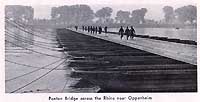 |
|
| On September 26, the 547th Engineer Construction Battalion, assisted by the 552d Ponton Bridge Company constructed a ponton bridge across the Rhine 2½ miles south of Oppenheim. The bridge, 1,000 feet long, was constructed between the hours of 8 a.m. and 5:30 p.m. It was dismantled the next day. In order to construct the bridge, the Rhine River had to be closed to traffic for the period. The Battalion had one day's practice in still water prior to the operation. The river is quite deep at the bridge site with rather rapid currents in the navigation channel. General Huebner and the staff of the European Command were highly gratified over the efficient manner in which the demonstration was executed. |
|
| |
|
|
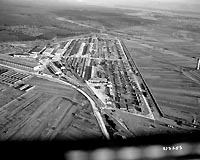 |
|
The Engineer Depot at Hanau has collected a vast volume of equipment and supplies left behind by Engineer units. The segregation and classification of the various items have been a tremendous job. The depot is now confronted with the problem of reconditioning the various items of construction equipment. In general thus is being handled by contract with German industrial firms. According to Colonel Martling, who was in command of the Granite City Depot prior to assuming command at Hanau, the Hanau Depot is the second largest Engineer Depot in our Army. |
|
The Engineer School at Murnau is located in the Bavarian Alps, a short distance from the city of Oberammergau, famous for the Passion Play. The principal activity of the school at the time of a recent inspection was conducting enlisted specialist courses for soldiers and German civilians connected with repair and utility work. In addition, certain courses were being conducted for enlisted personnel of the Constabulary to fit them for positions in tactical units, inasmuch as the Constabulary is being converted from a general policing unit into combat units.
Brig. Gen. Don G. Shingler, Chief Engineer of the European Theater, and his officers and men are to be congratulated for their magnificent work, although handicapped by lack of adequate and sufficient personnel. An outstanding example of this is the construction of the runways in Berlin where all equipment and material are being transported by airlift. Working in co-operation with the Air Force, heavy pieces of construction equipment such as D-8's have been transported by air. |
|
| |
| 332nd Engineer General Service Regiment |
|
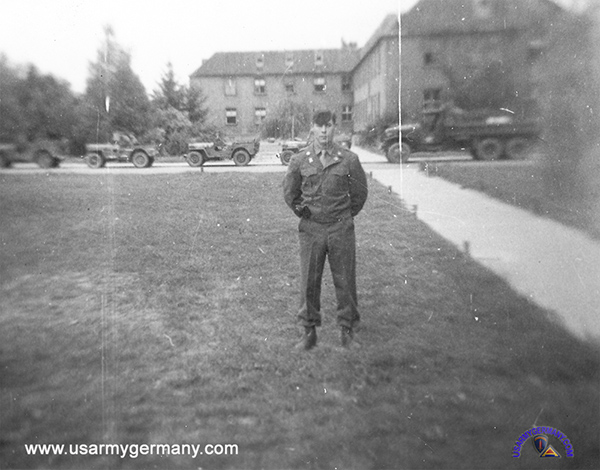
332nd Engineer GS Regiment, Wiesbaden Air Base, 1946
|
|
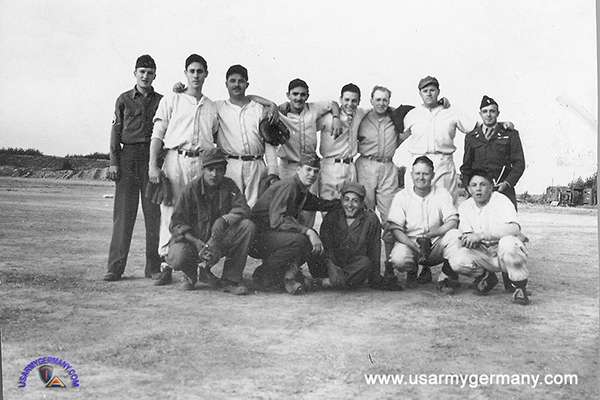
332nd Engineer Regiment baseball team in 1946
|
|
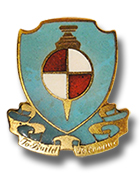 332nd Engineer GS Regiment Crest 332nd Engineer GS Regiment Crest |
|
| 1946 |
| (Source: Wikipedia) |
Railway Bridge Construction
The greatest accomplishment of the 332nd Engineer G. S. Regiment (as a member of ASDEC Engineer Group "A") was the reconstruction of the Duisburg-Hochfeld rail bridge, 2,815 feet (858 m) long, over the Rhine River in the record time of six days, fifteen hours and twenty minutes. The site of this bridge was crossing the Rhine River between Duisburg and Rheinhausen, Germany. The railroad bridge was completed 8 May 1945 and was named the "Victory Bridge".
In building the bridge, the Engineer Group had to finish the demolition of the nearby railway bridge. Near the new piers was part of a masonry bridge that looked similar to the Castle Design of the U.S. Army Corps of Engineers. This was a fitting tribute the Army Engineering.
Army of Occupation
The regiment remained in Germany in the Allied Occupation Zones in Germany under the command of the U.S. Fifteenth Army, later being deactivated in 1949 (should be 1947). By May 1946 the 332nd was actively involved in rebuilding the airstrip at Wiesbaden. At the time it was known as Fliegerhorst Wiesbaden. It came to be called Wiesbaden Army Airfield (WAAF) and is still in operation today.
After V-E day, the Army was interested in conditions affecting the morale of the troops in the Occupation Zones. To meet the needs of the troops the chief of special services offered programs with recreational athletics. Soldiers could engage in boxing, football, baseball, softball, tennis, golf, track & field, badminton, bowling, swimming, archery and horseshoe pitching. These activities fell under the Army Sports Program. |
|
|
| 1947 |
| (Source: Email from Mark Fields) |
Dad has been selected to go to Washington DC on an honor flight. He will turn 91 years old April 2 and we think the flight will be about that time.
Dad was happy to serve in the Army after enlistment in 1945. He was classified 4F in 1944 or so due to a heart murmur and did not serve during the war. But following his high school graduation in 1945, he was called again by the draft board and sent to a heart specialist who examined him. Dad had been a football player in high school until the 4F classification and regretted that classification. The heart specialist did a lot of testing, and said to Dad after the test were over “well son, you’re going to be a soldier” and Dad said those were the happiest words he had ever heard.
Though his enlistment date was not until Sept, 1945, he did his basic and other training and shipped out to Germany in early 1946 and arrived at Wiesbaden.
From Dad's Diary, May 8:
This was the first day I had a chance to make an entry in this. I am now, at last, stationed. It is the 332nd Eng, Reg’t. about 20 mi, outside Frankfort. Since today is a holiday (anniversary of V-E day) we did nothing today. I am anxious to know what kind of work I will be doing here. The food is good and it is served by German women. At least I won’t have any K.P. The church is in town. The name of the town is Wiesbaden. Since no buses run on Sunday morning I’ll probably have to walk about 3½ to 4 mi. to get there. This Eng. outfit is now rebuilding an air-strip.
From Dad's Diary, July 4:
Today is the 4th. The old tradition of firecrackers and lots of boom, boom is conspicuous for it’s absence. Most of the celebrating is taking place at the Company Club where the whiskey flows like buttermilk. There is going to be an air power demonstration in Frankfort this P.M. There will be a parachute jump with 9 C-47’s participating. About dinner time today 150 fighter planes of all classes put on a demonstration mainly for the Krauts benefit I think.
Dad was always interest in playing baseball and football.
In the summer of 1946 he was on the 332nd Engineers baseball team. They won the tournament (I think Dad scored the winning run) and they were given an R&R pass to Garmisch. They travelled to Munich to board a train, and wound up at a hotel in Garmisch.
One last item of interest. Dad has two clippings from a newspaper that were published regarding the football he played in Wiesbaden. They played at
Wiesbaden stadium which I suppose may not even exist any longer. He remembers as these being published in Star & Stripes. I've searched on
line and can't find anything about the football leagues. I'm sure they were recreation leagues but probably an important diversion for the post-war troops.
|
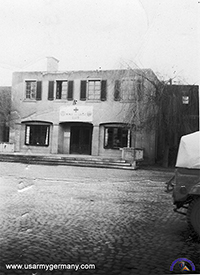
1. ARC Club |
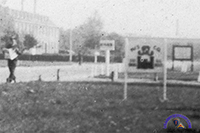
2. Wiesbaden Air Base |
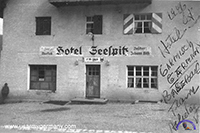
3.
Hotel Seespitz, Oberkirch
|
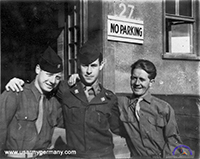
4. Barracks? |
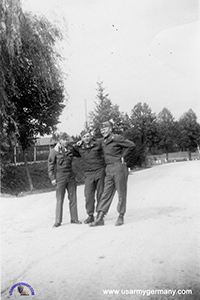
5. Buddies |
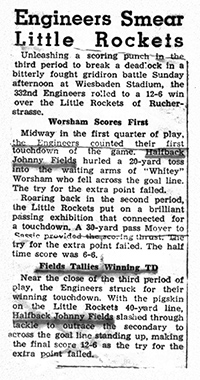
6. |
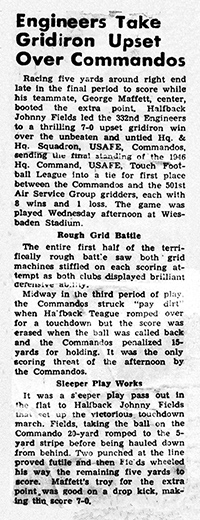
7. |
|
|
|
| |
Related Links:
|
| |
| |
|

 332nd Engineer GS Regiment Crest
332nd Engineer GS Regiment Crest 












